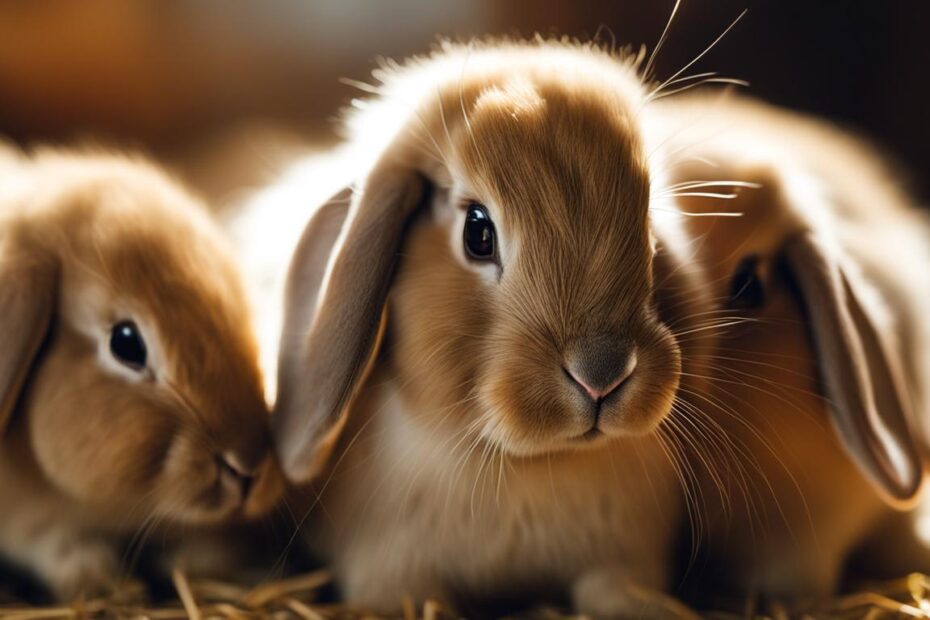If you’re a proud rabbit parent or simply curious about these furry creatures, you may wonder how rabbits feed their babies. In this comprehensive guide, we’ll explore the fascinating nursing behavior of rabbits and provide valuable insights into rabbit lactation. Understanding how rabbits care for their young is not only important for their well-being but also for the overall knowledge and care of these adorable animals.
Key Takeaways:
- Rabbits have a unique approach to feeding their babies.
- Mother rabbits only feed their kittens once a day for a limited time.
- The milk produced by the mother rabbit sustains the babies for 24 hours.
- It’s crucial to check the kits and ensure their health and well-being.
- Separating the father and considering neutering is recommended for both parents.
How Rabbits Feed Their Babies
Rabbit Nursing Habits and Milk Production
Mother rabbits have unique nursing habits when it comes to feeding their babies. They only nurse their kits once or sometimes twice a day, providing all the milk supply they need in that short period. This nursing behavior is a result of their natural evolution and ensures the kits receive the necessary nutrition for their growth and development. The kits rely on the mother’s milk for sustenance for the next 24 hours.
During the nursing session, the mother rabbit’s milk production is at its peak, providing the kits with rich and nutritious milk. The composition of the milk is designed to meet the kits’ specific dietary needs, promoting their healthy development. It is important to check the kits regularly to ensure they have round and distended bellies, indicating that they have nursed successfully. rabbit feeding habits
“The kits only nurse once or sometimes twice a day, and the doe’s milk sustains them for 24 hours.”
Rabbits have also developed a natural protective mechanism where the mother stays away from the nest for periods of time to avoid attracting potential predators. This behavior helps ensure the safety of the kits while allowing the mother to fulfill her nursing duties without drawing attention to the nest.
Table 2: Comparison of Rabbit Milk Production
| Mother Rabbit Breed | Number of Nursing Sessions per Day | Milk Supply Duration |
|---|---|---|
| Dwarf Rex | 1 | 24 hours |
| Flemish Giant | 1-2 | 24 hours |
| Holland Lop | 1-2 | 24 hours |
| Lionhead | 1 | 24 hours |
Understanding these nursing habits and milk production patterns is crucial for ensuring the well-being and proper care of rabbit kits. Regular monitoring and observation of the kits’ nursing behavior, along with providing a safe and comfortable environment for the mother, contribute to the healthy growth of the kits.
Checking and Caring for Rabbit Kits
Caring for baby rabbits involves checking and ensuring the health and well-being of the kits. It is important to monitor the nest and count the kits for their safety. The nest can be gently inspected the second morning after their arrival by moving aside the fur. This allows you to check if all the kits are alive and well. Unfortunately, there may be dead kits in the nest, and uneaten placentas may need to be removed to maintain a clean and hygienic environment.rabbit parental care
The mother rabbit rarely abandons or ignores her babies, but if there are concerns, it is recommended to check them early each morning. A healthy kit will have a round and warm belly, indicating that it has been properly nursed by the mother. If a kit has a visibly sunken or cool belly, it may require extra attention and care.
Monitoring the kits’ growth and ensuring they receive proper care from their mother is crucial. If any issues arise, such as the mother neglecting her young or problems with milk production, it is essential to consult a qualified rabbit-experienced veterinarian for guidance and assistance.
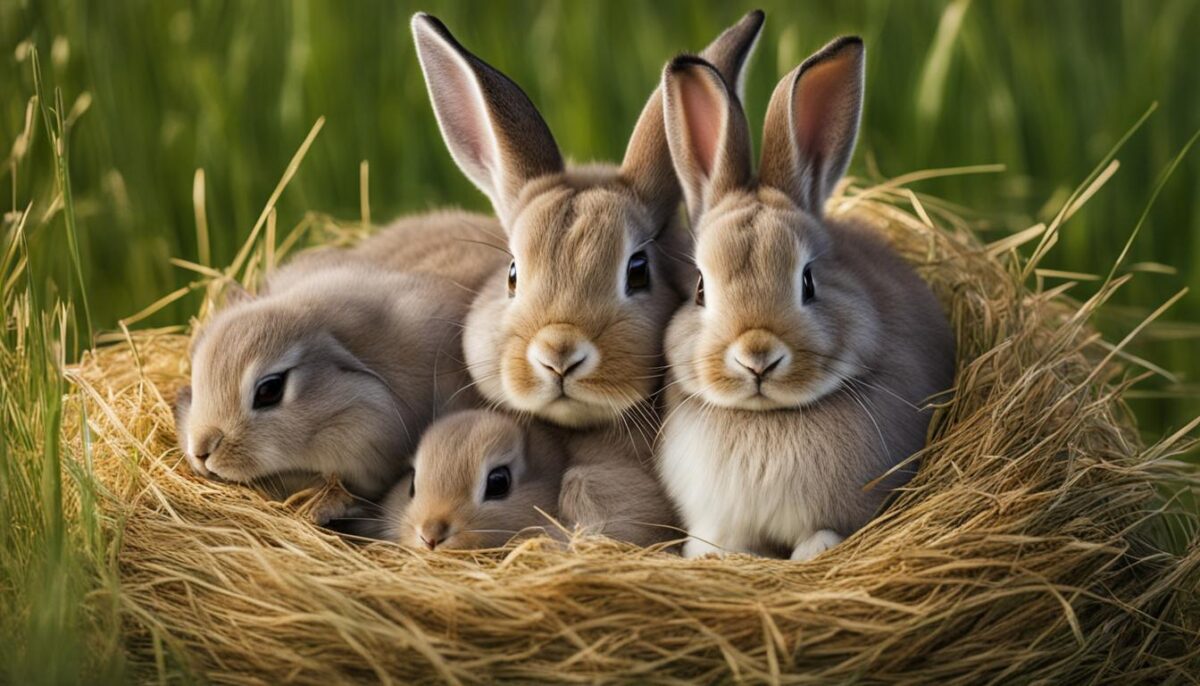
Table: Common Issues and Solutions for Rabbit Kits
| Issue | Solution |
|---|---|
| Mother neglecting kits | Consult a veterinarian and seek advice on hand-rearing the kits. Ensure they receive proper nutrition and care. |
| Insufficient milk production | Consult a veterinarian to determine if there are any underlying health issues affecting the mother’s ability to nurse. Supplemental feeding may be required. |
| Weak or dehydrated kits | Seek immediate veterinary intervention and supplemental feeding to ensure the kits receive the necessary nutrition and hydration. |
| Dead kits in the nest | Remove deceased kits from the nest for sanitary reasons and to prevent the spread of infection or disease. |
By actively monitoring and caring for the rabbit kits, you can ensure their healthy development and improve their chances of thriving under the care of their mother.
Separating the Father and Neutering
One of the key steps in caring for baby rabbits is separating the father from the mother after the birth of the kits. This is crucial to prevent the female from becoming pregnant again, as she can conceive within hours of giving birth. While most male rabbits are gentle with their offspring, it is still necessary to separate them to avoid further breeding.
However, it is recommended to house the male nearby where he can still see and have limited contact with the female, as this can help reduce stress for both rabbits. Neutering is highly advised for both the male and female rabbits. This not only prevents unwanted pregnancies, but also leads to longer, healthier lives for both rabbits and reduces stress-related sexual rabbit nursing behavior frustration.
| Benefits of Separation and Neutering for Rabbit Care | Male Rabbit | Female Rabbit |
|---|---|---|
| Prevents further breeding | ✓ | ✓ |
| Reduces stress-related sexual frustration | ✓ | ✓ |
| Prevents uterine cancer | ✓ | |
| Longer, healthier lives | ✓ | ✓ |
Separation should be done promptly after the birth of the kits. This ensures that the female rabbit can focus on caring for her babies without the risk of another pregnancy. Neutering is generally recommended around 4 to 6 months of age, but it’s best to consult a qualified veterinarian for advice on the appropriate timing for your rabbits.
Weaning the Rabbit Kits
As rabbit kits reach around 3 weeks old, they begin an important transition phase known as weaning. During this period, the kits start producing and consuming their caecotrophs, which are special night poos. They also start nibbling at solid food, preparing themselves to leave the nest and become more independent. This is an exciting time as the kits begin to explore their surroundings and interact with their littermates. nursing habits of rabbits
To support the kits’ development during the weaning process, it is crucial to provide them with fresh hay daily. This can be done by using the hay as bedding, ensuring the kits have constant access to it. Hay is an essential part of their diet and aids in proper digestion. Additionally, introducing small portions of fresh vegetables can help familiarize the kits with different flavors and textures, preparing them for a varied diet in the future.feeding baby rabbits
It is important to note that weaning is a gradual process that takes time. The kits should be observed to ensure they are transitioning well and showing signs of development. Continuing to monitor their growth and weight gain is essential, as this is an indication that they are successfully adapting to their new diet. As the kits become more independent and comfortable with solid food, they can be gradually separated from their mother and prepared for rehoming.
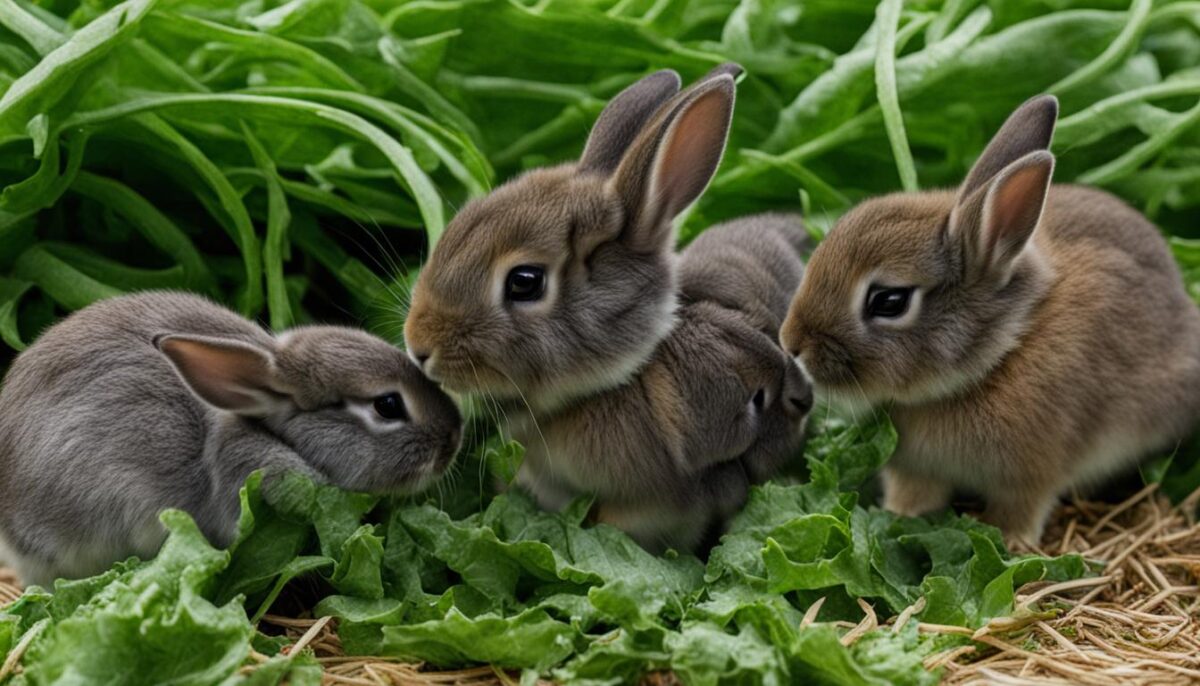
Table: Example Feeding Schedule for Weaning Rabbit Kits
| Age (in weeks) | Milk Feeding | Hay and Vegetables |
|---|---|---|
| 3 | 1-2 times per day | Introduce small portions |
| 4 | 1 time per day | Increased hay and vegetable consumption |
| 5 | Transition to solid food | Increase vegetable variety |
| 6-8 | Reduced milk feeding | Stable hay and vegetable diet |
The weaning process typically lasts from 3 to 8 weeks, depending on the individual kits’ development. It is important to provide a gradual transition from milk to solid food, allowing their digestive system to adjust. Keeping the kits near their mother and father for a few days after weaning helps them maintain social connections and reduces stress during the transition. With proper care and attention to their nutritional needs, the kits will grow into healthy and thriving rabbits ready for their new homes. rabbit milk production
Wild Rabbit Nesting Behavior and Care
Wild rabbits have a unique nesting behavior that allows them to raise their babies in a safe and hidden environment. They often choose seemingly exposed locations like the middle of a lawn or brush piles to build their nests. This strategy helps to camouflage the nest and minimize the risk of predators discovering it. Disturbing a wild rabbit nest can have dire consequences, so it’s best to leave it undisturbed and provide protection instead.
The nursing behavior of wild rabbits is different from domestic rabbits. A wild rabbit mother only visits the nest for a short period, typically early in the morning and evening, to feed her babies. She spends only about 5 minutes a day nursing her offspring. Even if the mother is not seen during the day, she will often return to call and feed her babies. It’s crucial not to disturb the nest during these periods to ensure the mother can safely care for her young.
Caring for wild rabbit babies requires caution and an understanding of their natural behavior. If you come across a disturbed nest with live babies, you can carefully restore the nest by placing the babies back in and covering them with fur and nesting materials. It’s best to keep a safe distance and observe from afar to avoid scaring the mother away. If you suspect the mother has abandoned the nest or the babies appear weak or injured, it’s important to contact a local wildlife rehabilitation center for guidance on how to provide the best care for these fragile creatures.
In summary, wild rabbit nesting behavior is fascinating and unique. Their choice of seemingly exposed locations helps protect their nests from predators. Understanding their nursing behavior and the importance of not disturbing the nest is crucial for their survival. If you encounter a disturbed nest, it’s best to restore and protect it rather than bringing the infants inside. If there are concerns about the welfare of wild rabbit babies, it’s best to consult professionals who specialize in wildlife rehabilitation.
Understanding Domestic Rabbit Pregnancy and Care
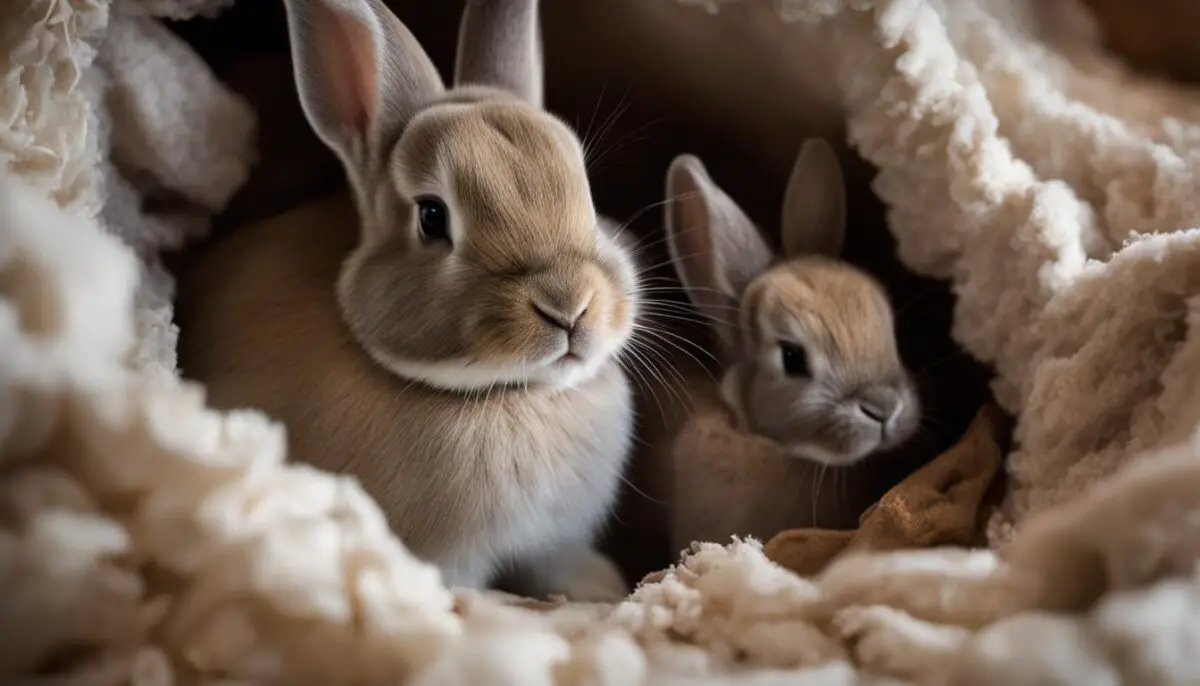
Caring for a pregnant domestic rabbit requires special attention and understanding. To ensure the well-being of both the mother and her unborn kits, proper care and preparation are essential. One of the first steps is to separate the father from the mother’s presence to prevent further breeding and potential stress to the mother.
It is important to accurately sex the rabbits to avoid any unexpected pregnancies. Once the mother is pregnant, it is crucial to monitor her behavior and provide a secure and comfortable nesting area. A quiet, secluded space with appropriate bedding, such as straw or shredded paper, will help the mother feel safe and secure.
“Caring for a pregnant domestic rabbit requires special attention and understanding. It is crucial to accurately sex the rabbits to avoid any unexpected pregnancies.”
Caring for Orphaned Rabbit Kits
In some cases, the mother may not be able to care for her kits, or the kits may become orphaned for other reasons. Caring for orphaned rabbit kits is a delicate process and requires special knowledge. It is essential to consult a qualified rabbit-experienced veterinarian for guidance and advice.
When caring for orphaned kits, it is crucial to replicate the natural nursing schedule as much as possible. Feeding them every few hours with a suitable milk replacement formula will help ensure their proper growth and development. The kits should be kept in a warm and quiet environment and should be handled gently and with care to minimize stress.
| Important Considerations: | Tips for Caring for Orphaned Kits: |
|---|---|
| Consult a qualified veterinarian for guidance and advice | Use a suitable milk replacement formula |
| Replicate the natural nursing schedule as much as possible | Keep the kits in a warm and quiet environment |
| Handle the kits gently and with care | Monitor their growth and development closely |
Caring for pregnant rabbits and orphaned kits requires patience, knowledge, and attention to detail. By providing a safe and nurturing environment, along with the proper nutrition and veterinary care, domestic rabbits can thrive throughout the pregnancy and nursing process. Remember to always seek professional advice and support to ensure the best possible care for these adorable creatures.
Signs and Intervention for Rabbit Nursing Issues
When it comes to rabbit nursing, there can be various issues that arise, both with the mother rabbit and the baby kits. It is important to be aware of these signs and know when veterinary intervention may be necessary. Some common problems include baby rabbit feeding problems and mother rabbit lactation issues.
If you notice that the mother rabbit is not feeding her babies or showing no signs of lactation, it is crucial to seek veterinary help immediately. This could indicate a problem with the mother’s health or milk production. Weak or dehydrated kits may also require supplemental feeding and veterinary intervention to ensure their well-being.
“Proper nutrition and care are essential for the health and growth of baby rabbits. If you have any concerns about the mother’s ability to nurse or the kits’ overall health, don’t hesitate to reach out to a qualified veterinarian.”
Monitoring the growth and development of the kits is vital in detecting any potential nursing issues. Checking the babies’ bellies for roundness and distention is a good indication of proper feeding. Additionally, observing the mother’s behavior and inspecting her nipples for signs of lactation can provide insights into whether intervention is necessary.
| Nursing Issue | Signs | Intervention |
|---|---|---|
| Baby Rabbit Feeding Problems | Weakness, dehydration, lack of interest in nursing | Veterinary consultation, supplemental feeding |
| Mother Rabbit Lactation Issues | No signs of milk production, failure to nurse | Veterinary consultation, possible medication or treatments |
Remember, providing proper nutrition and care for baby rabbits is essential for their healthy development. If you have any concerns about the mother’s ability to nurse or the kits’ overall health, don’t hesitate to reach out to a qualified veterinarian who can provide the necessary guidance and intervention.
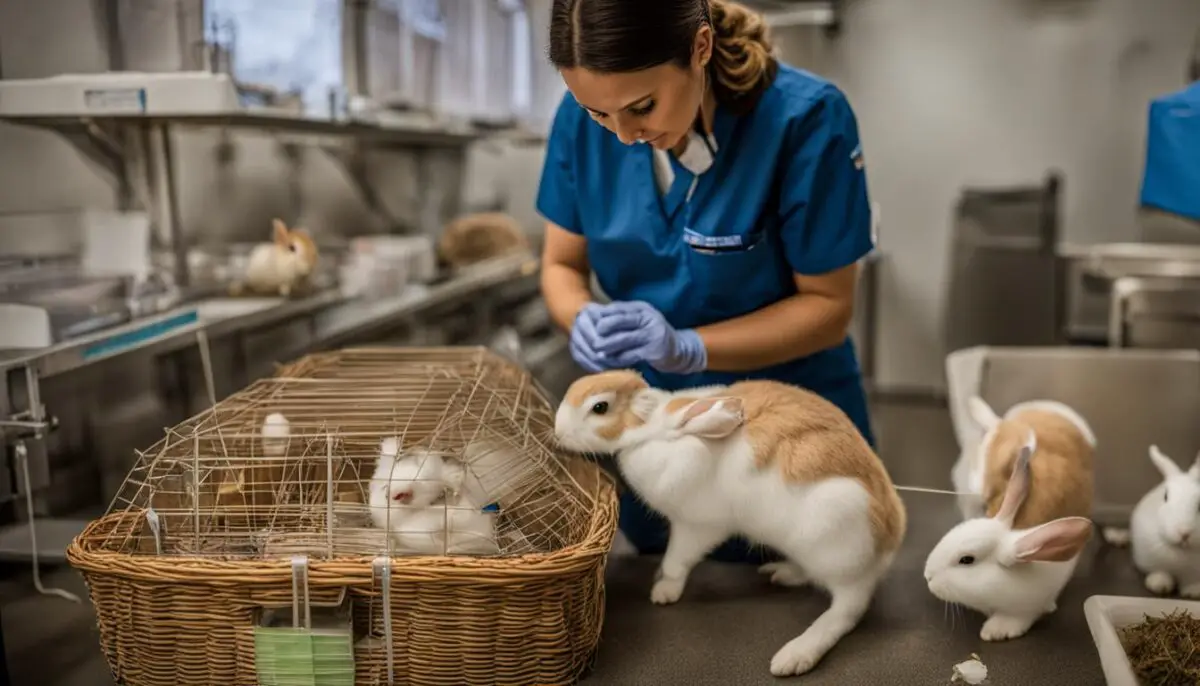
Conclusion
Understanding proper rabbit baby care is crucial for ensuring the health and well-being of these adorable creatures. From their unique nursing behavior to the importance of checking the kits and providing a safe environment, there are several key factors to consider.
Separating the father from the mother after birth and considering neutering for both parents helps prevent further breeding and promotes longer, healthier lives for the rabbits. Gradual weaning and the introduction of solid food are essential steps in the development of the kits, ensuring they grow into independent and healthy rabbits.
Whether dealing with wild rabbit nesting behavior or domestic rabbit pregnancy, it’s important to respect and understand their natural instincts. Consulting a rabbit-experienced veterinarian is crucial in cases of nursing issues or inadequate milk production to ensure the best care for the baby rabbits.
Caring for baby rabbits requires knowledge, patience, and a deep understanding of their unique nursing behavior. By following these guidelines and providing the necessary care, you can experience the joy and fulfillment of raising happy and healthy rabbit kits.
FAQ
How often do mother rabbits feed their babies?
Mother rabbits only feed their babies once or twice a day, providing all their milk supply in that short time.
How many babies can a rabbit have?
The average litter size for rabbits is 7, although they can have up to 15 kits.
When do baby rabbits start eating solid food?
Around 3 weeks old, rabbit kits start nibbling at solid food and producing caecotrophs, which are special night poos.
Why is it important to separate the father rabbit?
Separating the male rabbit is crucial to prevent further breeding, as the female can conceive within hours of giving birth.
When can baby rabbits be separated from their mother?
Around 6 to 8 weeks old, the kits become independent and can be separated into new homes. Gradual removal of the larger kits helps prevent the mother from developing mastitis.
What should I do if I find a wild rabbit nest?
It’s best to restore and protect the nest if it has been disturbed by a dog or other factors. Wild rabbit mothers only visit the nest early in the morning and evening to nurse their babies.
How should I care for a pregnant domestic rabbit?
The first step is to remove the male rabbit from the female’s presence to prevent further breeding. It’s important to consult a qualified rabbit-experienced veterinarian for advice on caring for a pregnant rabbit.
What should I do if the mother rabbit is not feeding her babies?
If the mother rabbit is not feeding the babies or shows no signs of lactation, it is important to seek veterinary help immediately. Young and nervous mothers may need extra support and guidance.
What are the signs of proper nursing in baby rabbits?
Properly nursed baby rabbits should have round, warm bellies that indicate they have fed and are being cared for by the mother.


